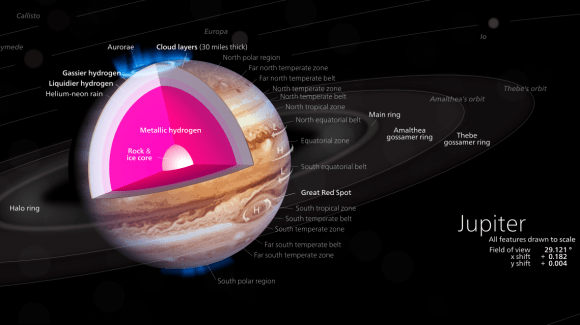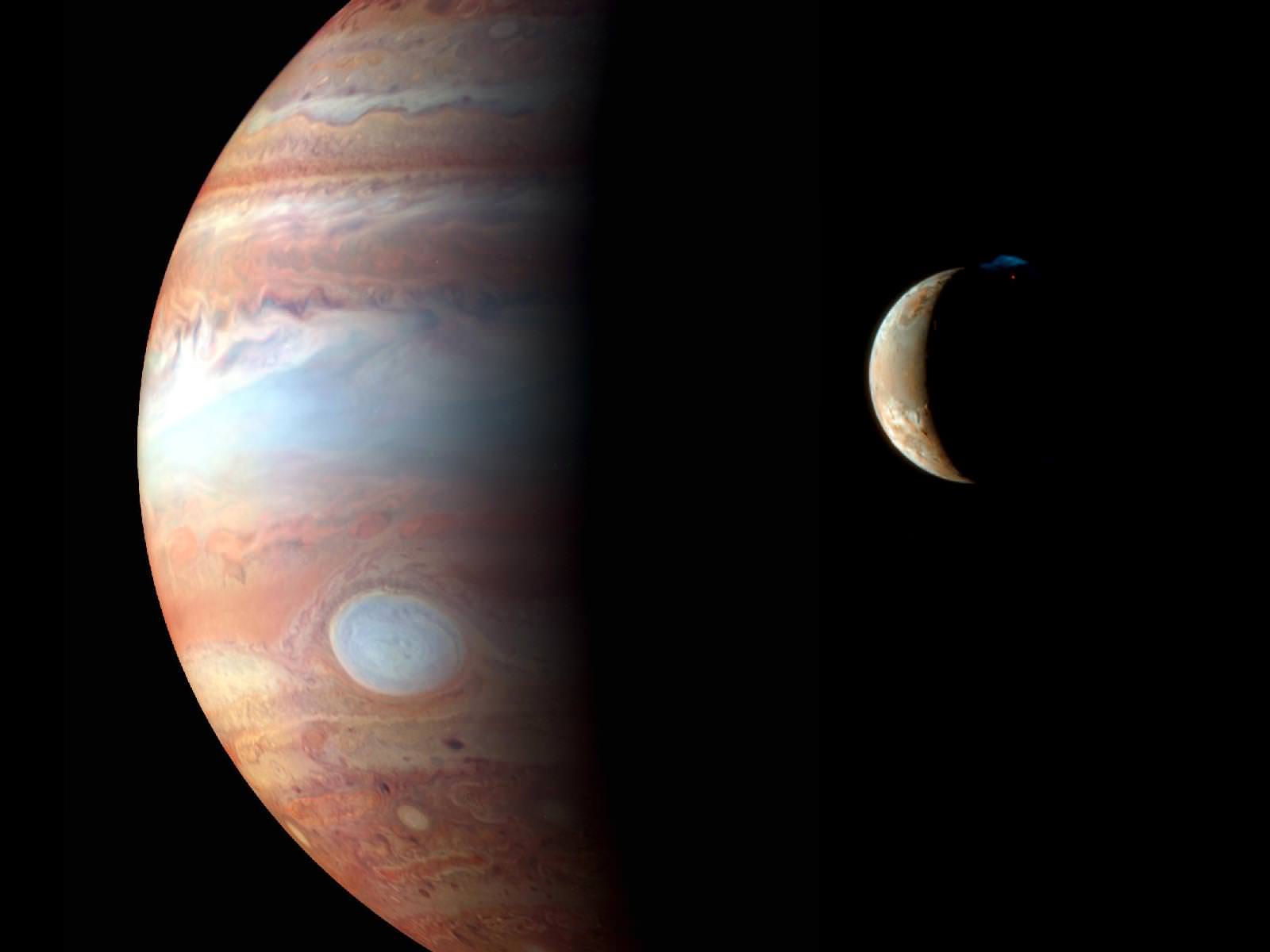Ever since the invention of the telescope four hundred years ago, astronomers have been fascinated by the gas giant of Jupiter. Between it’s constant, swirling clouds, its many, many moons, and its Giant Red Spot, there are many things about this planet that are both delightful and fascinating.
But perhaps the most impressive feature about Jupiter is its sheer size. In terms of mass, volume, and surface area, Jupiter is the biggest planet in our Solar System by a wide margin. But just what makes Jupiter so massive, and what else do we know about it?
Size and Mass:
Jupiter’s mass, volume, surface area and mean circumference are 1.8981 x 1027 kg, 1.43128 x 1015 km3, 6.1419 x 1010 km2, and 4.39264 x 105 km respectively. To put that in perspective, Jupiter diameter is roughly 11 times that of Earth, and 2.5 the mass of all the other planets in the Solar System combined.
But, being a gas giant, Jupiter has a relatively low density – 1.326 g/cm3 – which is less than one quarter of Earth’s. This means that while Jupiter’s volume is equivalent to about 1,321 Earths, it is only 318 times as massive. The low density is one way scientists are able to determine that it is made mostly of gases, though the debate still rages on what exists at its core (see below).
Composition:
Jupiter is composed primarily of gaseous and liquid matter. It is the largest of the gas giants, and like them, is divided between a gaseous outer atmosphere and an interior that is made up of denser materials. Its upper atmosphere is composed of about 88–92% hydrogen and 8–12% helium by percent volume of gas molecules, and approx. 75% hydrogen and 24% helium by mass, with the remaining one percent consisting of other elements.

The atmosphere contains trace amounts of methane, water vapor, ammonia, and silicon-based compounds as well as trace amounts of benzene and other hydrocarbons. There are also traces of carbon, ethane, hydrogen sulfide, neon, oxygen, phosphine, and sulfur. Crystals of frozen ammonia have also been observed in the outermost layer of the atmosphere.
The interior contains denser materials, such that the distribution is roughly 71% hydrogen, 24% helium and 5% other elements by mass. It is believed that Jupiter’s core is a dense mix of elements – a surrounding layer of liquid metallic hydrogen with some helium, and an outer layer predominantly of molecular hydrogen. The core has also been described as rocky, but this remains unknown as well.
In 1997, the existence of the core was suggested by gravitational measurements, indicating a mass of from 12 to 45 times the Earth’s mass, or roughly 4%–14% of the total mass of Jupiter. The presence of a core is also supported by models of planetary formation that indicate how a rocky or icy core would have been necessary at some point in the planet’s history in order to collect its bulk of hydrogen and helium from the protosolar nebula.
However, it is possible that this core has since shrunk due to convection currents of hot, liquid, metallic hydrogen mixing with the molten core. This core may even be absent now, but a detailed analysis is needed before this can be confirmed. The Juno mission, which launched in August 2011, is expected to provide some insight into these questions, and thereby make progress on the problem of the core.
The temperature and pressure inside Jupiter increase steadily toward the core. At the “surface”, the pressure and temperature are believed to be 10 bars and 340 K (67 °C, 152 °F). At the “phase transition” region, where hydrogen becomes metallic, it is believed the temperature is 10,000 K (9,700 °C; 17,500 °F) and the pressure is 200 GPa. The temperature at the core boundary is estimated to be 36,000 K (35,700 °C; 64,300 °F) and the interior pressure at roughly 3,000–4,500 GPa.
Moons:
The Jovian system currently includes 67 known moons. The four largest are known as the Galilean Moons, which are named after their discoverer, Galileo Galilei. They include: Io, the most volcanically active body in our Solar System; Europa, which is suspected of having a massive subsurface ocean; Ganymede, the largest moon in our Solar System; and Callisto, which is also thought to have a subsurface ocean and features some of the oldest surface material in the Solar System.
Then there’s the Inner Group (or Amalthea group), which is made up of four small moons that have diameters of less than 200 km, orbit at radii less than 200,000 km, and have orbital inclinations of less than half a degree. This groups includes the moons of Metis, Adrastea, Amalthea, and Thebe. Along with a number of as-yet-unseen inner moonlets, these moons replenish and maintain Jupiter’s faint ring system.
Jupiter also has an array of Irregular Satellites, which are substantially smaller and have more distant and eccentric orbits than the others. These moons are broken down into families that have similarities in orbit and composition, and are believed to be largely the result of collisions from large objects that were captured by Jupiter’s gravity.

Interesting Facts:
Much like Earth, Jupiter experiences auroras near its northern and southern poles. But on Jupiter, the auroral activity is much more intense and rarely ever stops. The intense radiation, Jupiter’s magnetic field, and the abundance of material from Io’s volcanoes that react with Jupiter’s ionosphere creates a light show that is truly spectacular.
Jupiter also has a violent atmosphere. Winds in the clouds can reach speeds of up to 620 kph (385 mph). Storms form within hours and can become thousands of km in diameter overnight. One storm, the Great Red Spot, has been raging since at least the late 1600s. The storm has been shrinking and expanding throughout its history; but in 2012, it was suggested that the Giant Red Spot might eventually disappear.
The discovery of exoplanets has revealed that planets can get even bigger than Jupiter. In fact, the number of “Super Jupiters” observed by the Kepler space probe (as well as ground-based telescopes) in the past few years has been staggering. In fact, as of 2015, more than 300 such planets have been identified.
Notable examples include PSR B1620-26 b (Methuselah), which was the first super-Jupiter to be observed (in 2003). At 12.7 billion years of age, it is also the third oldest known planet in the universe. There’s also HD 80606 b (Niobe), which has the most eccentric orbit of any known planet, and 2M1207b (Lerna), which orbits the brown dwarf Fomalhaut b (Illion).
Scientist theorize that a gas gain could get 15 times the size of Jupiter before it began deuterium fusion, making it a brown dwarf star. Good thing too, since the last thing the Solar System needs if for Jupiter to go nova!
Jupiter was appropriately named by the ancient Romans, who chose to name after the king of the Gods (Jupiter, or Jove). The more we have come to know and understand about this most-massive of Solar planets, the more deserving of this name it appears.
If you’re wondering, here’s how big planets can get with a lot of mass, and here’s what is the biggest star in the Universe. And here’s the 2nd largest planet in the Solar System.
Here’s another article about the which is the largest planet in the Solar System, and here’s what’s the smallest planet in the Solar System.
We have recorded a whole series of podcasts about the Solar System at Astronomy Cast. Check them out here.
Sources:


HOW CAN SOMETHING THAT HAVE NO BEGINING OR END EXPAND(THE UNIVERSE), OR IS IT JUST THE “MATTER” EXPANDING ?
AND HOW COME SCIENTISTS TALK OF “THE EDGE OF THE UNIVERSE”, IF THE UNIVERSE IS ENDLESS ?
We know that our Universe had a beginning just in theory, many of the proofs made in the CERN points on that, mathematics as well are doing the part in guess what would be the moment in which our Universe started to exist.
Now, we know that our Universe is since then in a constant and accelerated expansion, that gives an imaginary shape of our Universe, if is in expanding there is suddenly a border or an edge, our Universe is not endless it has an age that determinate its size. What are beyond that edge? That is another question. My answer would be: “nothing” since nothing has happened to be existed beyond of existence, got sense?
Cheers!
Well technically there is no requirement for “beginning” in the big bang theory. Also technically it was not a “bang” at all, just the universe that grew from small to big. How do we know? Well that is what we can measure.
Also when you look at vacuum, it is full of virtual participles that spontaneous pop into existence and disappear again giving an “impression” that vacuum is empty. So nature seems to like spontaneous creation of mass all the time and then make it disappear again.
Also we don’t know if there is an edge or not, because we can only see back light from 13.82 billion years ago. Space itself might be infinite, but what we can see is limited.
Yes a vacuum is not an empty of meant nothing, is just a lack of matter, but as you said a vacuum is an empty space, so is “something”. What I am referring to “nothing” is what are beyond of the space expansion, if you could travel to that very moment you would find that the space and time are intertwined. So beyond that you can’t find something, even better, you can find nothing.
Make this question to yourself, -if the Universe is in expanding, where do this is happening?-
time to bring out Holst…. https://www.youtube.com/watch?v=Nz0b4STz1lo
And then there were the collisions….
Most recent one – https://www.youtube.com/watch?v=RNKtzAppLHg
I don’t think we can call Jupiter a planet, because it did not clear is orbit. There are still Trojans left. We should call Jupiter a “dwarf” planet.
Bazinga!
What started the great red spot? How can it have remained stable for over 4 centuries?
I remember the Shoemaker-levy bombardment and dark spot at the “crater” site. Can a larger object have caused the GRS? A former KBO or moon that hit Jupiter slowly and remain as a gigantic floating iceberg under the cloud layers, spewing out gases as it melts or something like that?
Its my fist post here so go easy on my wild hypothesis. 🙂
No worries, Simen. And might I say, that IS a wild hypothesis, but it might just be crazy enough to make sense! Keep those theories coming 😉
So what is now the true size of Jupiter… without the clouds!? It looks like a “slim” toon figure with several layers of clothing.. coats… parkers… sweaters… all at once.